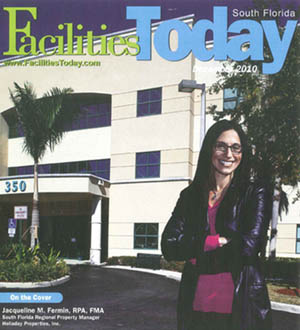(Plantation, FL) – Jacqueline Fermin, Holladay Properties’ South Florida Regional Property Manager, wrote an article that was published in the December 2010 edition of Facilities Today.
Her article titled “Medical Property Managed Offers Stable Ground in Shaky Economy”, details the difficulties medical property managers face versus tradition commercial real estate managers, despite the stability of medical real estate industry.
The following article was published in Facilities Today in December 2010
Upon recently becoming the South Florida Regional Property Manager for the healthcare division of Holladay Properties, I have developed a tremendous appreciation for the stability found in South Florida’s medical real estate industry in a time when the economy continues to struggle. However, the consistency enjoyed in medical property management does not come easy. Medical property managers face challenges not found when managing other types of properties. It begins with developing a comprehensive understanding of the healthcare industry and ultimately leads to secure tenants and owners that have a high level of confidence in its property management team.
As healthcare providers increasingly turn to medical office buildings and outpatient facilities to help balance demand and costs in an unsettled economy, it is vital for property managers to establish themselves as experts in the healthcare field. For facility owners, the property management team is a strategic partner whose knowledge of the overall healthcare environment allows it to facility unique medical policies and procedures, such as regulatory compliance, HIPPA privacy codes, after-house access and medical waste requirements to name a few. Ultimately this industry knowledge reduces risk for both tenant and owner.
Medical properties experience more foot traffic than your average office building. Patients traveling in and out of physician offices deal with ailments ranging from the common cold to pink eye. Therefore, sanitizing common areas and individual suites, as well as securing the specialized equipment found in physician offices, are extremely important. The demographics of the foot traffic are also unusual. The increased number of children and elderly require a heightened sense of awareness to the conditions of common areas.
The payoff for the additional hurdles involved in medical property management is steadiness in the market. That resilience was one of the initial differentiators I experienced after transitioning to medical property management from several years as a property manager for more traditional commercial real estate properties in South Florida.
At Holladay, my team manages the South Florida portfolio, which stretches from West Palm Beach to Miami. It is compressed of nine medical office properties totaling 402,000 square feet with a 93% occupancy rate. We intend to grow the South Florida portfolio in 2011 by at least 100,000 square feet while pushing its occupancy rate above 95%. Judging by the momentum generated in 2010 and the continued stability in the medical real estate market, I feel confident we will be able to accomplish our objectives.

